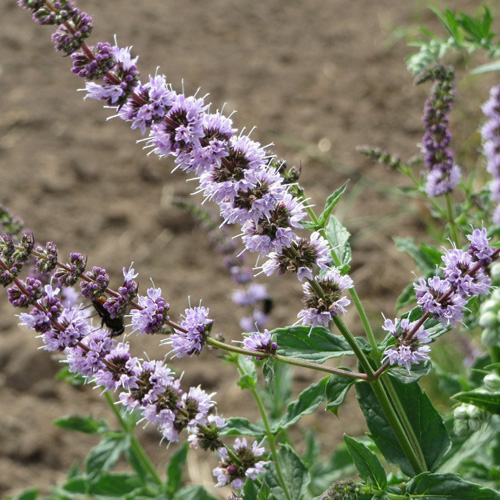- Home
- News
- Consumer Reading Room
- Spearmint Oil - Origin, Use, Benefits and Applications
Spearmint Oil - Origin, Use, Benefits and Applications

With Halloween at our doorstep, the time of potions and secret recipes is coming. And one famous and 100% natural ingredient, that our R&D witches team uses frequently in our cosmetics, is the spearmint oil. Let’s learn more about this ancient herb origin and why it is so commonly used in health-food products, toothpaste, mouthwashes, cosmetics, aromatherapy and as well in medicine for its claimed therapeutic properties.
Origin

Spearmint, known scientifically as Mentha Spicata, is one of at least thirty species in the extensive Lamiaceae, better known as the mint family. You can recognize it from the other herbs with the spear shape of its leaves (which gives it its name) and its purple boom flowers. It is a Mediterranean native perennial herbaceous plant (meaning that it only lives 2 years), that we can trace back at least to the 1st century. Domesticated by the Romans, who brought it to Britain, and then shipped it to America with the first British colonists, Spearmint can easily adapt to all temperatures as well as grow in various types of soil, explaining why we can find it worldwide nowadays.
Use and benefits

Although peppermint and spearmint may share many of the same properties and benefits, there are significant differences. Contrary to peppermint which contains 40% menthol, giving it its “minty” flavor great for cooking, spearmint has less than 1% making it ideal for the creation of aromatic oil, called oil of spearmint. We could assume that spearmint essential oil is extracted from the leaves, but it actually comes from the steam distillation of the Spearmint plant's leaves, stems, and/or flowering tops. The most abundant compound we can find in spearmint oil is carvone and other volatile oils, flavonoid thymosin, caffeic acid derivatives, rosmarinic acid, and limonene.
For centuries, spearmint has been used for its digestive benefits, often being served with or after meals in order to help digestion, as an ingredient in Ayurvedic medicine, a holistic healing system that believes that health and wellness depend on the balance between the mind, body, and spirit, and as a natural remedy to soothe skin problems, throat aches and headaches. It was even used in Ancient Greece as an aphrodisiac! By now, it has been proven to have different properties like being anti-fungal, anti-bacterial,... as well as helping to avoid indigestion due to its high concentration of carvone providing antispasmodic, carminative, and sedative effects.
Applications of spearmint
As mentioned before, spearmint has had many rules and roles over time, but nowadays there are 3 uses that shine over the rest, its cometic, aromatherapy and medicinal use.
1. Cosmetic
Stimulant, antioxidant, antiseptic, anti-bacterial, anti-inflammatory, antioxidant.
Seen its properties and its pleasant light smell, we use spearmint oil in our Arau Baby Laundry Soap, helping to make sure the baby’s laundry will be rid of bacteria and smooth for your baby’s delicate skin. But you will also find it commonly in toothpaste, mouthwash, hair and body wash. It is also one of the main ingredients of cream to relieve the pain from insects or mosquitos bites.
2. Aromatherapy
Antispasmodic, stimulant, restorative, expectorant, anti-depressant, carminative, decongestant.
Spearmint essential oil is a somewhat more subtle oil than peppermint since it contains significantly less menthol, so it's softer fragrance makes it easier to use every day in aromatherapy. It can relieve nasal congestion, headaches, throat aches, stomach pains, as well be used to deodorize a room while relaxing the body. It can also be used in combination with other essential oils, for example, we use it with our Golden Jojoba Oil in our Aroma Life range.
3. Medicinal
Antiseptic, antispasmodic, disinfectant, stimulant, restorative, analgesic, anti-inflammatory, anti-fungal, anti-bacterial, carminative, decongestant, anti-oxidant.
Contrary to what we can think, using spearmint in toothpaste is not that much for its characteristic fresh flavor, but more for its antibacterial and antimicrobial properties, which may help kill the bacteria in your mouth that cause bad breath. You will find it as well in syrups for throat aches, or to relieve bronchitis. It is also very useful to deal with digestive problems, including nausea, flatulence, and hiccups as it relaxes the stomach muscles.
As all the essential oils, it is necessary to be cautious while using it and not take excessive amounts. As well, it is not recommended to use it when you are pregnant or breast-feeding. Stay on the safe side, always follow the quantity recommendations checking on the label of the products or the healthcare professional dosage.
Improving the sanitation, the environment, and health of the world.
Social

© Copyright Saraya.Co.Ltd 2023 All rights reserved.